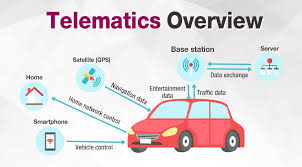Learning that your car is snitching on you and sending data to a third party is odious. But it joins other technologies, called telematics, that reveal where we go and how we get there.
The capability to track a vehicle comes from years of academic and military research. The mission of telematics 101 began with the best of intentions. Before we had hand-held phones, transportation engineers explored the utility of connected cars. Their goal was to reduce traffic congestion and save lives. Connected cars, using telematics, could travel in platoons, signal tie-ups to each other, and improve fleets. When the connected car was first envisioned it was a boon for safety and efficiency.
Now, thirty years later, there is new meaning to the connected car. The vehicle you drive today is more likely to connect to a database, not to other road users. In a series of New York Times articles since March 2024, Kashmir Hill reveals how General Motors vehicles equipped with OnStar service can track speed, driving behavior, and geolocation. They also sell this data. It appears that other vehicle makers engage in similar data logging.
Like the connected cars that transportation engineers once worked on, GM’s OnStar program began with good intentions. Onstar was started by automotive engineers so that they could electronically pinpoint equipment failures, provide traffic reports, and study, and publish, safety studies. The original OnStar service, which rolled out in 1996 was costly, but for those who subscribed, it provided a human voice. That was useful in case of a traffic accident or other emergency. Since then, the need for Onstar functions has been usurped by smartphones. So, that might be one of the reasons that General Motors looked for a new market and began selling (or trading) personal tracking data to Lexis-Nexis and insurance companies. We don’t know.
However, General Motors is not alone. For some time there have been different types of tracking. g The Tesla owner’s manual describes two recording systems. One called Sentry mode uses cameras to capture motion and activity when the vehicle when is stationary. So, If someone tries to break in, an alert is sent to the owner’s phone. When the Tesla is being driven, another recording device is activated, called the dash-cam. There is yet a third system: The Tesla, and other cars with assisted driving features, have a front facing camera to alert drivers when they take their gaze off the road or are less alert. As in the early days of connected cars, engineers need this data to improve assisted driving and ultimately, make the autonomous car safer. But it’s not clear what other uses the data can be put to.
“Cars now run on the new oil: your data.”
That was a wry comment made by a Washington Post technologist back in 2019. Five years ago a car could generate 25 gigabytes of data from its cameras, computers, and sensors. It’s probably larger today. There are no federal laws regulating what carmakers can collect or do with driving data, although General Motors may have crossed the line when they knowingly sold (or traded) OnStar data to third parties.
In a morph from car to smartphone, the newest Apple software provides many benefits of the original OnStar service. In ‘SOS’ mode Apple phones transmit your current location over satellites. RoadSide Assistance can then summon a tow-truck or repairs in the absence of cellular or wi-fi connectivity. And, finally, if your car is in a collision, there is an emergency function that will automatically call for 911 emergency services. The phone’s inference is that the driver and passengers have been badly injured, and cannot respond on their own.
The idea that we are leaving a bread-crumb trail “whenever and whenever” is not so new. Like many concepts in new technology, it begins with public safety and better connectivity. Then it morphs. Over time, OnStar is less valuable for engineering purposes and more valuable for sales and marketing. OnStar is currently caught in the privacy cross-hairs but smartphones, doorbells, and television sets are already leavening the trail.

